12 of the world's most extraordinary and beautiful weather phenomena — and what makes them happen
We can all identify bolts of lightning, rainbows and stormy skies, but what of some of the earth’s more unusual and most spectacular weather phenomena? Here, photographers explain the science behind their astounding images in an extract from ‘Royal Meteorological Society: Weather A–Z’.


For those who love nothing better than to obsess about the weather, a book called Royal Meteorological Society: Weather A–Z — recently published by the Royal Meteorological Society and the Natural History Museum — will probably be the best £12.99 you'll ever spend, as this extract shows.
Jacob’s ladder
Photographer and location: Michelle Cowbourne, Somerset
When sunbeams penetrate the gaps in a layer of low cloud, they can be rendered luminous by water or dust particles in the air — an effect named after the ladder to heaven dreamt of by the biblical patriarch Jacob.

Crepuscular rays
Mario Widmer, South Tyrol, Italy
Originally applied to shafts of light radiating upwards in the sky just after the sun has set — the Latin word ‘crepusculum’ means twilight. It is now also used to describe shadowed bands cast by clouds at any time of the day. Often, the beams and shadows appear to radiate from a single point in the sky, streaming through gaps in clouds or between objects such as buildings and trees.

Green flash
Dusty Dhillon, Kent
Watching a glorious sunset is one of life’s great pleasures. As the glowing orb descends slowly beneath the horizon, the sky can progress through a kaleidoscope of colour, with oranges, reds, deep blues and violets putting on a show. But, every now and then, when the sun is nearly below the horizon, this familiar spectacle will be interrupted by a dramatic and unexpected interloper: a momentary, but very clear flash of bright green light — a small vivid, luminous explosion just above the top of the sun that has no place in your picture-perfect sunset. After a moment of wondering if you saw it at all, the question becomes, what was it? What you have just seen is called, prosaically enough, a ‘green flash’. And they’re not only confined to sunsets — they can also occur around sunrise and usually last for no more than a second or two.
Exquisite houses, the beauty of Nature, and how to get the most from your life, straight to your inbox.

Green flashes are more likely to be seen in stable clear air, when the observer has a clear view of a low horizon, usually over water. The explanation lies in the fact that our atmosphere acts like a prism, refracting light on its journey to the surface, but also partly in scattering and absorption. Light moves more slowly in the lower, denser air than in the thinner air above, separating the different colours.
Green and blue rays from the upper limb of the setting sun remain visible to the naked eye after the longer-wavelength red and orange rays are below the horizon and the yellow rays have been absorbed. Blue light is more readily scattered around on its journey through the atmosphere — hence our blue skies — so the light that ultimately ends up reaching us makes the very upper edge of the setting sun look green. This in turn is enhanced by mirage effects that distort the green shape we see.
Brocken spectre
Jim Frost, Cairngorms, Scotland
The Brocken spectre appears when the low sun is behind an observer who is looking downwards into mist or cloud from a ridge or peak. The spectre — a shadowy figure, standing in the distance — appears to be terrifyingly large, but is simply the shadow of the climber projected forward through the mist.
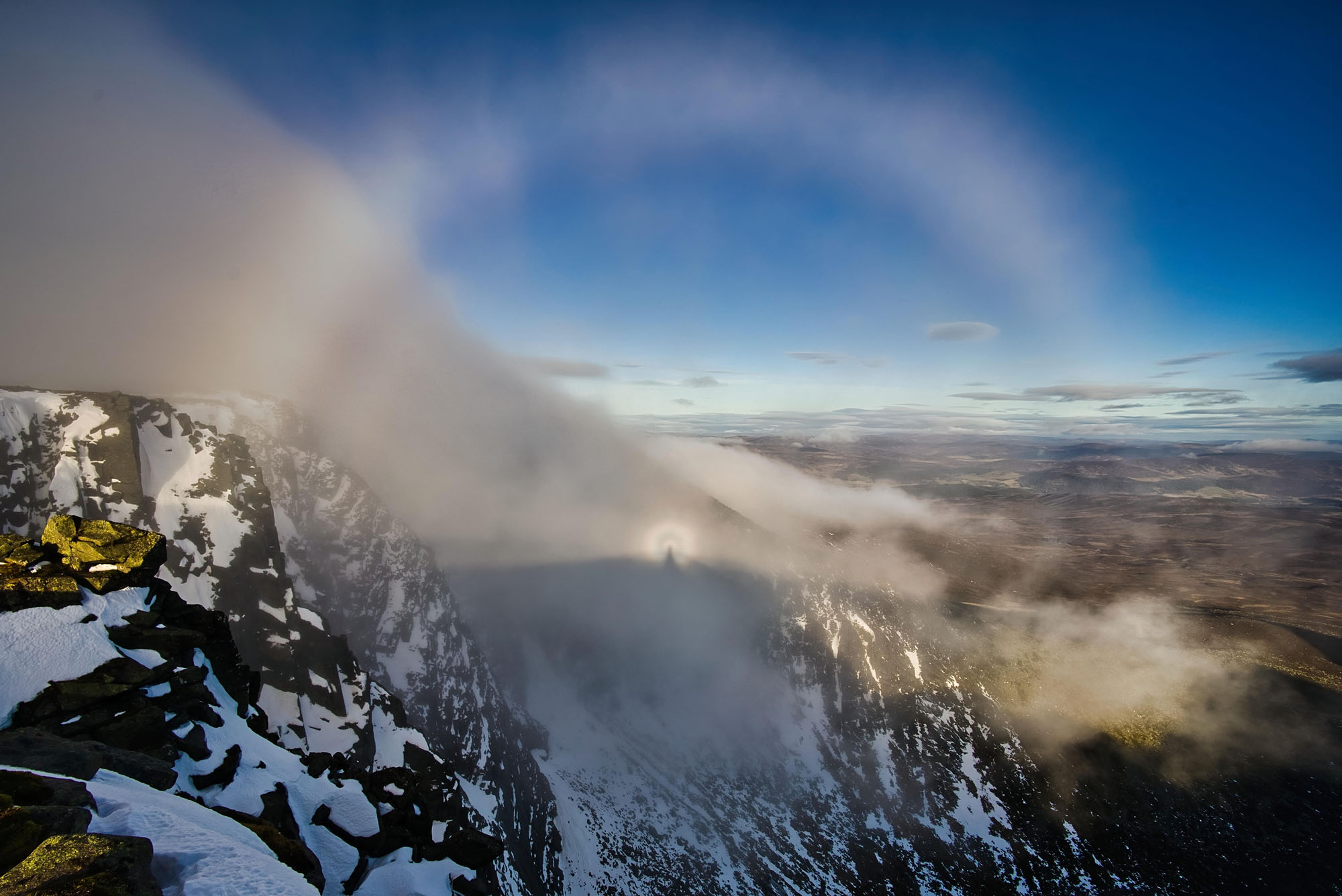
Iridescent clouds
Helen Dacre, Davos, Switzerland
Clouds formed of tiny evenly sized ice crystals that appear to be randomly tinted with patches of red, green, blue and yellow caused by the diffraction of sun or moonlight by the ice crystals. The word ‘iridescent’ originates from the Greek word for rainbow. In ancient Greece, the rainbow goddess was called Iris. Iridescent clouds can be seen in the UK as far south as Norfolk in cold weather.
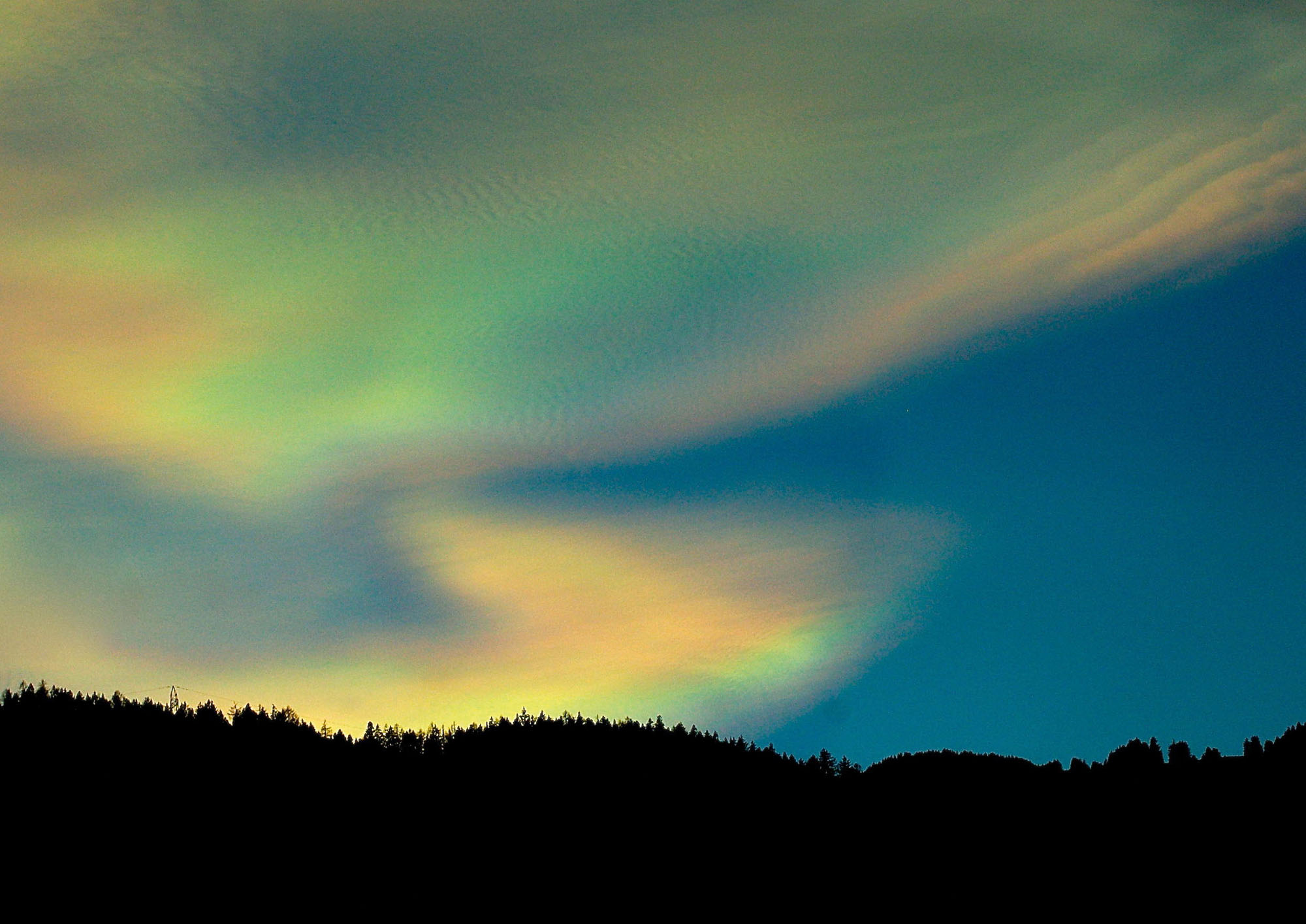
Double rainbow
Cammie Czuchnicki, Burlington, on the Kansas-Colorado border, US
On days when you spot a dark cloud on the horizon, creeping closer with ominous signs of rain falling from its base, there are times when Nature can distract you from thoughts of an impending soaking by delivering a perfect colourful arc in the sky — a rainbow.
A rainbow is a group of concentric arcs with colours ranging across the spectrum from violet to red, produced on a ‘screen’ of water drops in the atmosphere by light from the sun or the moon. Those water drops are usually raindrops from shower clouds, but could be spray from a waterfall or a fountain, or even those in fog. The conditions for all are the same — the observer must have their back to the light source and the water droplets must be in front.

Sunlight is made up of a spectrum of different colours that will slow down and change direction when entering water. This is known as refraction — each colour with its different wavelength will bend at slightly different angles so that the light splits into its different component colours. If the angle is right, some of that light will be reflected off the internal surface of the raindrop, exiting the drop and refracting again, so that ultimately we see the rainbow with the red band on the outside. Every observer will see a slightly different angle of refraction, so each rainbow is unique to that person.
How much we see of the arc depends on where we are and how high the sun is in the sky. When the sun is higher in the sky, we may see a shallow arc close to the horizon, but being nearer sunrise or sunset gives the best chance of seeing a full tall semi-circle. From a plane, the top of a mountain or with a hose in your garden, it is possible to see a full circle.
If you’re lucky, there are times you can see two for the price of one. There may still be no pot of gold, but a double rainbow can be doubly rewarding and they’re not that uncommon if you know to look for them. The second bow appears about 10˚ above the primary bow, but fainter and nearly twice as wide. They are formed when light is reflected twice within a raindrop, resulting in a second arc with the colour order reversed. The band between the two arcs, known as Alexander’s band (after Alexander of Aphrodisias, who described it in AD200) is dark, as the light is being bent away from the observer.
Fog
Mik Dogherty, Corfe Castle, Dorset
Fog is a suspension of water droplets or ice crystals in the surface layer of the atmosphere, occasionally accompanied by smoke particles, which reduces visibility to less than half a mile. Freezing fog is fog that forms when the air temperature is less than 0˚C (32˚F), often depositing rime on surfaces.
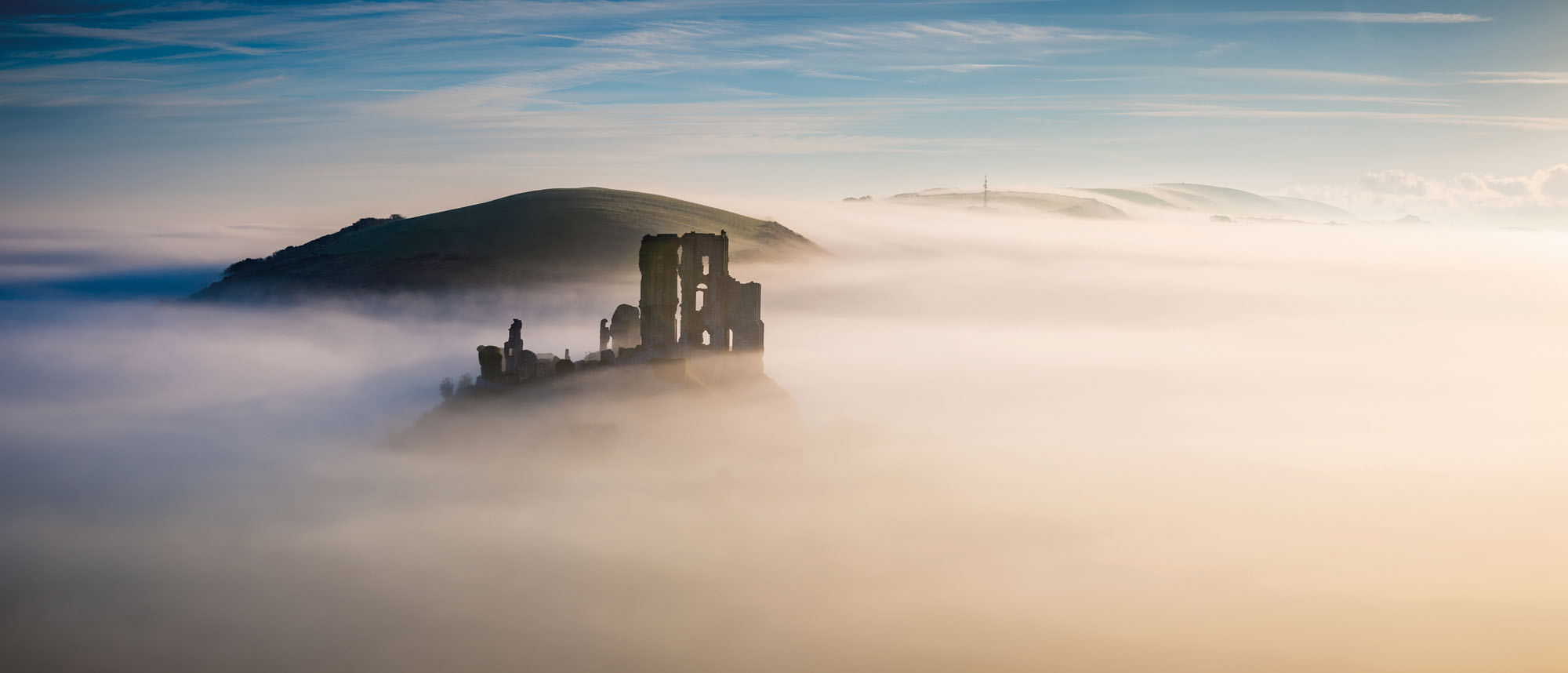
Fogbow
Scott Robertson, Glencoe, Scottish Highlands
A fogbow, or ‘white rainbow’, is a rainbow visible within fog. They are usually a similar size, but broader than a rainbow. Its outer margin has a reddish tint and its inner margin a bluish tint, but the central band is white.
They can be seen by an observer, still with sunlight behind them, looking at a thin fog or mist bank. Sunlight must pass through much smaller water droplets, less than 1mm (0.04in) in diameter, that make up the fog or mist. In these much smaller droplets, diffraction, rather than refraction, becomes the dominant process.
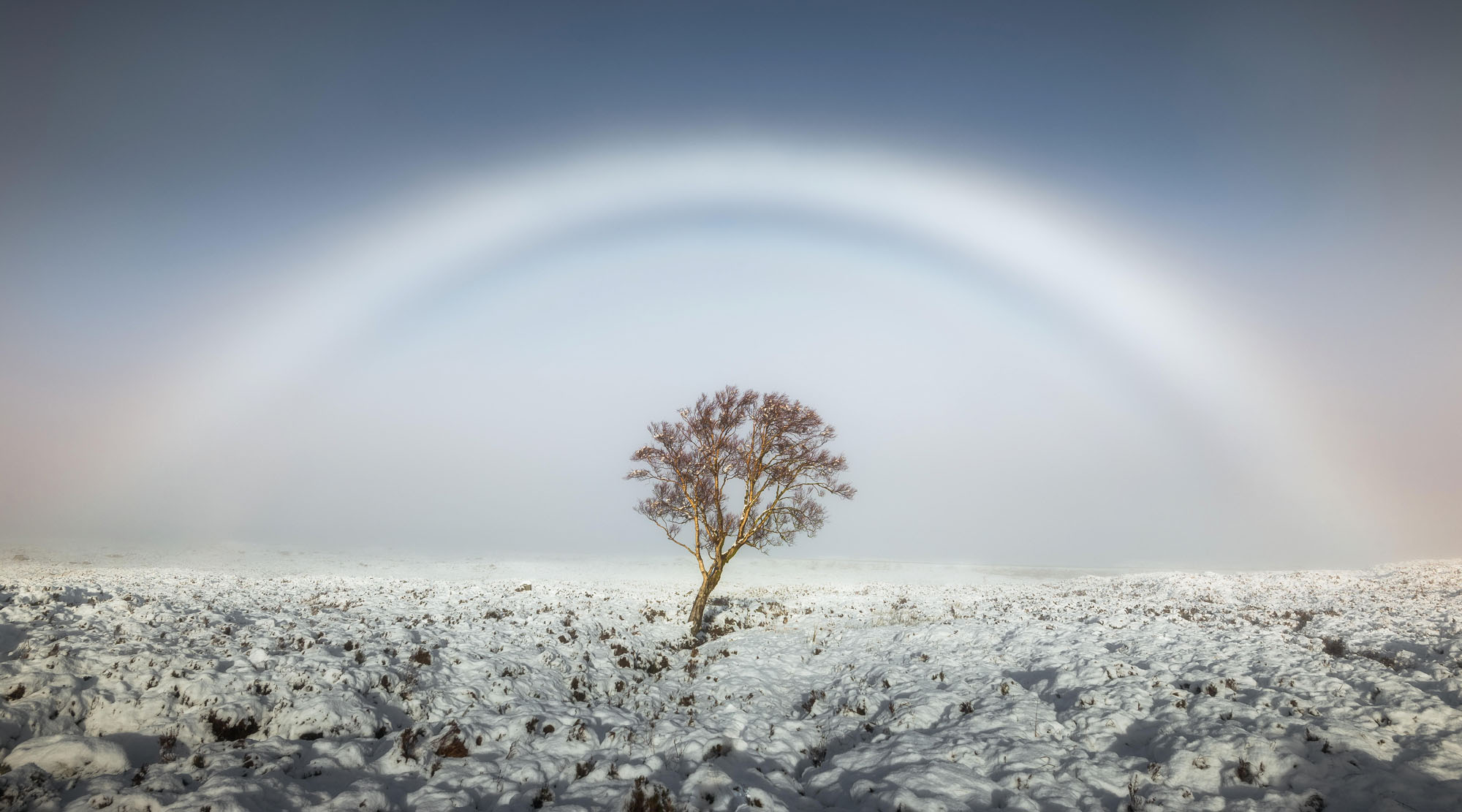
Aurora
Vitaliy Novikov, Murmansk region, Russia
As children, painting the perfect sky was easy, dipping the paintbrush in one colour without any doubt — after all, the sky is blue. When sunlight enters our atmosphere, it is scattered in all directions by gases and particles in the air. Blue light has the shortest wavelength and is scattered more easily than other colours and that’s why it’s the colour we see. Except sometimes it isn’t — it is possible to look upwards and see a spectacular display of multicoloured light dancing around the clear night sky. So, why is it different? The answer lies in the fact that these lights have been created by gases in the atmosphere and you’ve just seen the aurora — if you’re in the northern hemisphere, they’re known as aurora borealis, or the Northern Lights, and in the southern hemisphere, aurora australis, or the Southern Lights.
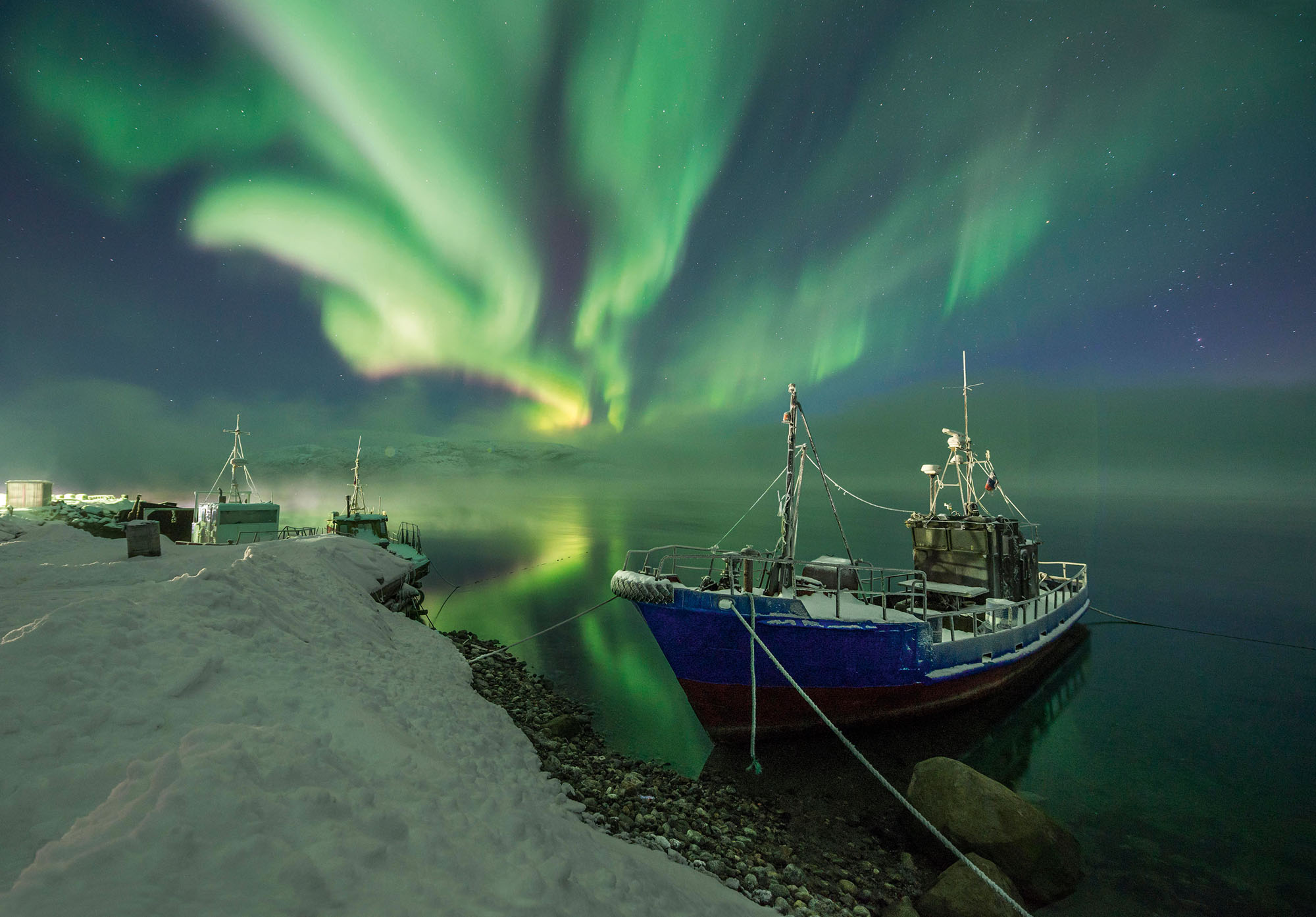
It does still all come back to the sun, as a ball of plasma releasing a constant stream of electrically charged particles called the solar wind. This wind moves around the solar system, bumping into planets, including Earth, on its way. Earth is surrounded by a magnetic field, called the magnetosphere, which protects it from the solar wind, essentially stopping the atmosphere from being swept away into space. Occasionally, there are an increased number of particles — a coronal mass ejection — and the force is enough that, when they collide with the magnetosphere, they break through, heading down along magnetic field lines, triggering the aurora.
Auroras are a riot of colour, most commonly seen as a pale green or pink light, but they can also be violet, blue, yellow and occasionally orange or white. Why the colour? When the particles enter our atmosphere, they smash into gas molecules there, breaking them apart. When those molecules come back together again, they’ve got more energy than they need and so release the excess as coloured light. Different gases will emit a different coloured light, with oxygen molecules at Aurora about 60 miles above the Earth’s surface responsible for green light and at 200 miles up, red. Nitrogen molecules produce blue, violet and red light.
Polar stratospheric clouds
Alan Tough, Alloa, Scotland
High-altitude clouds that form in the stratosphere above polar regions in the extreme cold of winter. Some forms made up of small, supercooled water droplets and nitric acid are known to play a role in the Antarctic ozone hole by providing a surface for chemical reactions that produce an ozone destroying form of chlorine to occur.

Parhelion or sun dogs
Michal Krzysztofowicz, Halley Research Station, Antarctica
On days when high cirrostratus clouds are visible in the sky, whether that be ahead of an approaching frontal system or on a benign, bright day, it’s possible you may see a bizarrely named sun dog in the sky. Confusingly not bearing any resemblance to a dog, it can often be seen on the side of a halo that circles the sun.
Parhelion are one of the most commonly spotted halo phenomena. They are produced by the refraction or reflection of sunlight by ice crystals suspended in the atmosphere. They can be very bright, red coloured closest to the sun or may just be visible as a smudge in the sky. The parhelic circle is a white horizontal band, in line with the sun, passing through the site of the parhelion. If it’s seen in its complete form, it stretches all around the sky, but is usually broken into smaller sections.
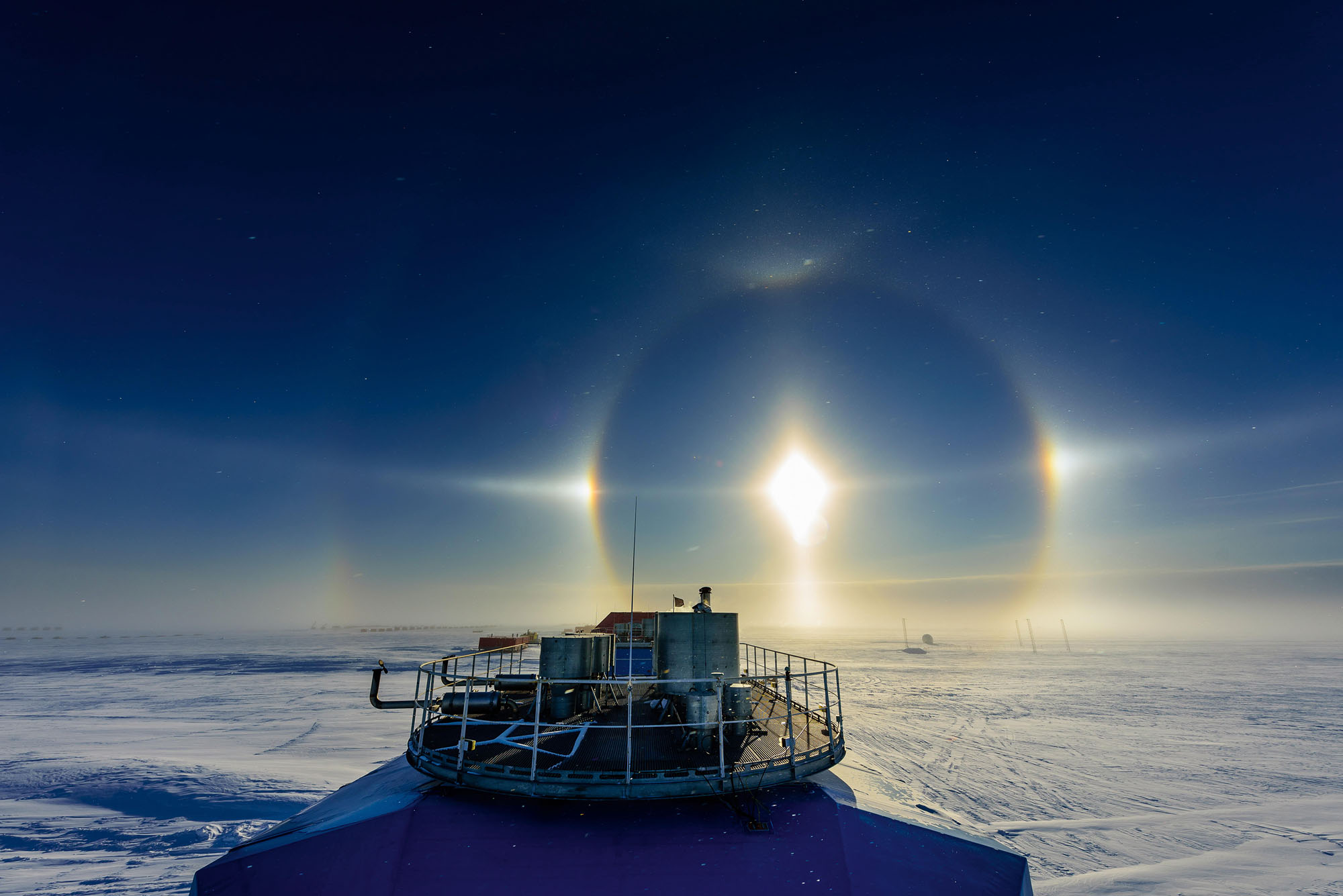
Air discharge
Shaun Mills, Mersea Island beach, Essex
A term used for a flash of lightning from a cloud into the adjacent air that does not reach the ground. Also known as streak lightning.
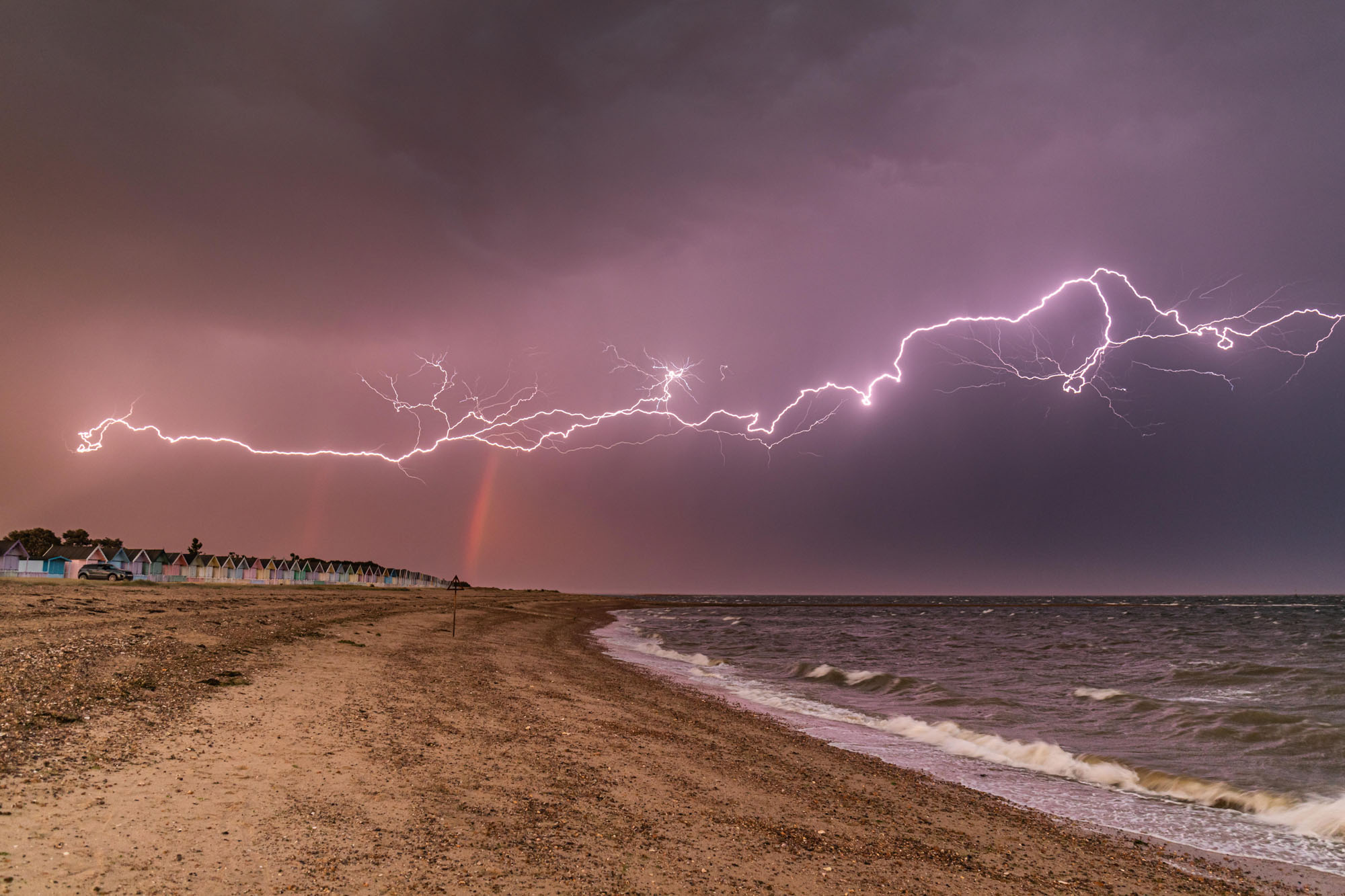
This is an extract from ‘Royal Meteorological Society: Weather A–Z’, published by the Royal Meteorological Society and the Natural History Museum (£12.99)
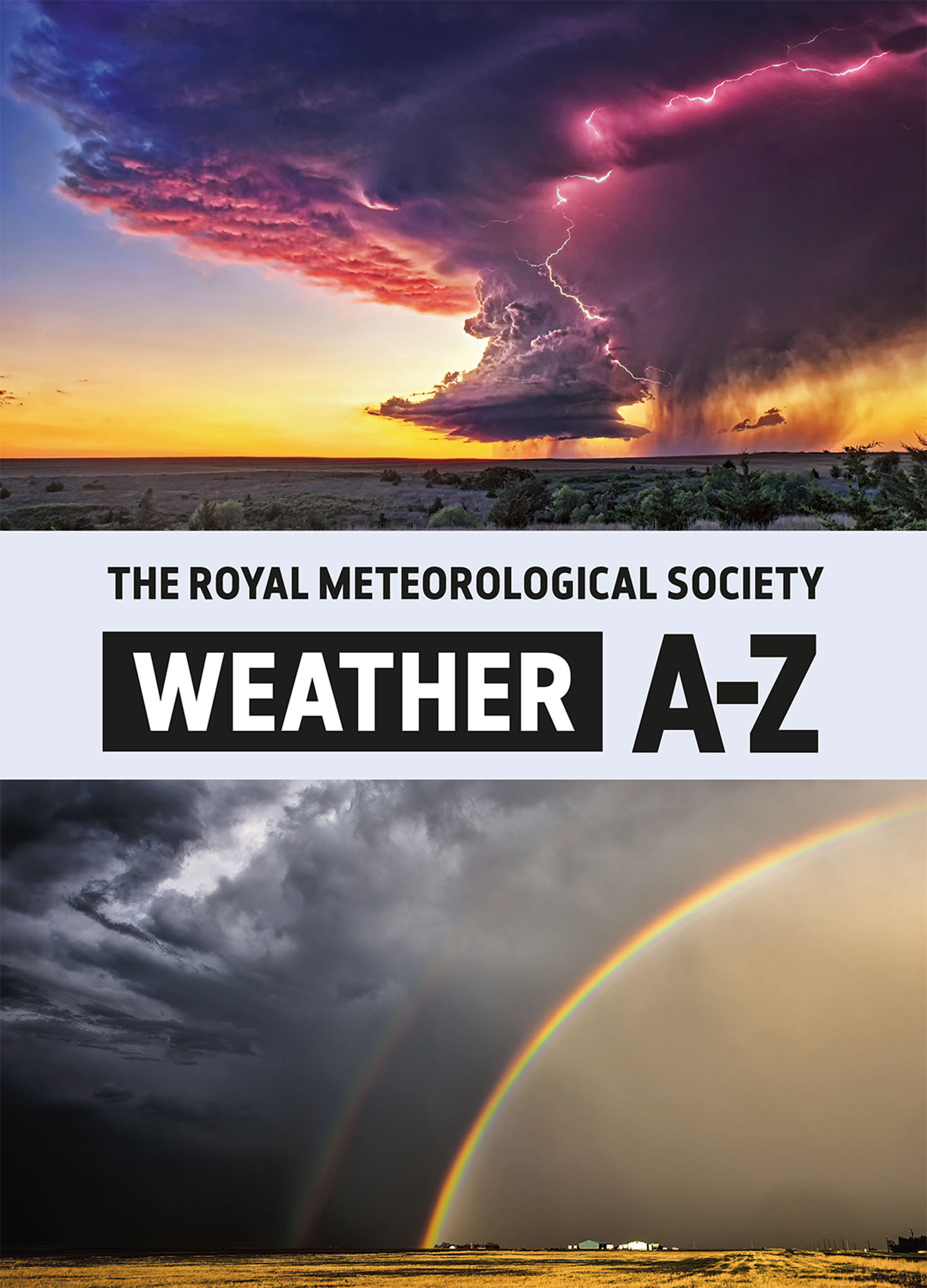

From mizzle to drizzle and dreich to dibble: 17 fascinating British words for wet weather
Mizzle, drizzle, dreich and dibble are just some of the many ways we describe rain. Antony Woodward considers our obsession

Credit: Getty Images
Curious Questions: Are weather forecasts really as bad as you think they are?
Weather forecasters might not always get it right, but technology is making meteorology more of an exact science than it

Curious questions: Who first classified the clouds?
Martin Fone investigates the scientists so intrigued by cloud formations that they decided to sort them out into different types.

The 10 types of cloud you'll see in Britain (and what they tell us about the weather)
Country Life is unlike any other magazine: the only glossy weekly on the newsstand and the only magazine that has been guest-edited by His Majesty The King not once, but twice. It is a celebration of modern rural life and all its diverse joys and pleasures — that was first published in Queen Victoria's Diamond Jubilee year. Our eclectic mixture of witty and informative content — from the most up-to-date property news and commentary and a coveted glimpse inside some of the UK's best houses and gardens, to gardening, the arts and interior design, written by experts in their field — still cannot be found in print or online, anywhere else.
